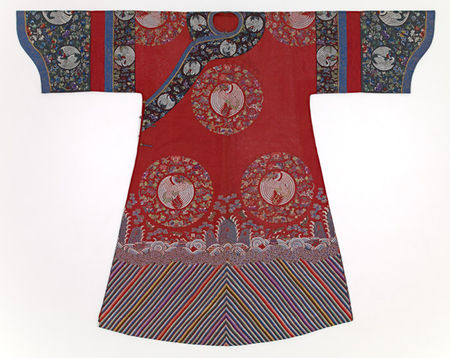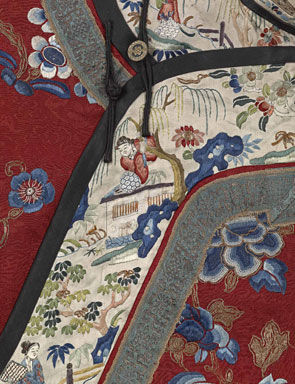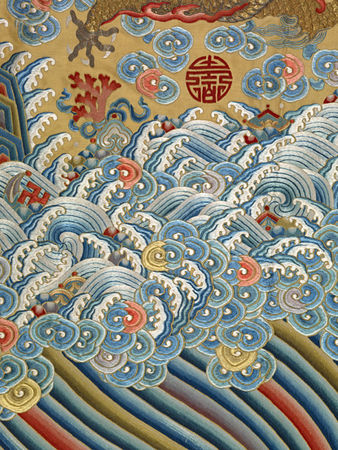"Dressed to Rule: Imperial Robes of China" @ The National Gallery of Victoria, Melbourne
Court lady’s robe (Neitao or Chenyi) (late 19th century) China, silk, silk gauze, silk and metallic thread, metal 143.0cm (centre back); 53.5 cm (sleeve length) Private collection, Melbourne
MELBOURNE.- The National Gallery of Victoria presents Dressed to Rule: Imperial Robes of China, a fascinating exhibition exploring the political and cultural meanings in the design and symbolism of the robes of Imperial China.
Focusing on the Qing dynasty period (1644–1911), Dressed to Rule features robes worn by the Qing Emperor of China and members of his imperial court at the Forbidden City in Peking (present-day Beijing).
Dressed to Rule features over 40 works drawn mainly from the NGV Collection, providing a glimpse of the political, social and cultural life inside the court in Peking. The exhibition includes magnificent robes, undergarments made of bamboo beads, headdresses, hats and shoes made for bound feet.
Dr Mae Anna Pang, Senior Curator Asian Art, NGV said: “The sumptuous imperial robes are woven in exquisite silk and embellished with gold and jewel-like rainbow colours. A cosmic order is created by the celestial dragons and auspicious symbols of nature.
“Qing robes combined Chinese elegance with the robust, barbaric splendour of the Manchu. The robes bear witness to a confrontation of two different cultures, the nomadic Manchu and the sedentary Chinese, the conqueror and the conquered,” said Dr Pang.
A highlight of the exhibition is a bright yellow semi-formal court robe known as a jifu (auspicious robe) that was once worn by a Manchu emperor for banquets and festivities. The delicate robe is decorated with traditional Chinese emblems of imperial authority and symbols of good fortune.
Dr Gerard Vaughan, Director, NGV said the robes, a major and surprising gift to the NGV made in the 1920s, represented a special and spectacular part of the Gallery’s permanent collection of Asian art.
“It is wonderful that we are able to showcase these beautiful and elegant robes as part of our Asian Art Collection. This is a special opportunity for visitors to see this impressive collection of imperial robes - some of which have never been on display before - and appreciate the important role these ceremonial robes played in China’s imperial history,” said Dr Vaughan.
Manchu horsemen crossed the Great Wall of China in 1644 and ruled China under the name of the Qing dynasty (1644–1911) for nearly three hundred years. As a minority ethnic group ruling 150 million Chinese, they had to adopt Chinese ways to govern the Chinese majority. To retain power, however, they also had to maintain their own martial superiority and preserve their language and dress.
The Manchu asserted their own cultural identity by imposing on the Qing court their traditional tribal hairstyle and clothing. They replaced the flowing, voluminous robes and flamboyant slippers of the previous Chinese Ming dynasty (1368–1644) with boots, trousers and coats modelled upon their Manchu riding habits.
The majority of robes on display were gifted through the Bequest of Dr George Morrison in the 1920s.
Dressed to Rule: Imperial Robes of China will be on display at NGV International, St Kilda Road from 17 April to 6 September 2009. NGV International is open 10am–5pm, closed Tuesdays. Entry to this exhibition is free.
Chinese lady’s coat (Ao) (detail)(late 19th century) China silk, silk and metallic thread, gilt, 103.0 cm (centre back); 44.0 cm (sleeve length) Private collection, Melbourne.
Uncut semi-formal court robe (Jifu) (detail) (mid 19th century) China silk, silk and metallic thread, 153.0 x 141.8 cm. National Gallery of Victoria, Melbourne. Gift of John H. Connell, 1914

/https%3A%2F%2Fprofilepics.canalblog.com%2Fprofilepics%2F1%2F0%2F100183.jpg)
/https%3A%2F%2Fstorage.canalblog.com%2F03%2F02%2F119589%2F96711876_o.jpg)
/https%3A%2F%2Fstorage.canalblog.com%2F11%2F31%2F119589%2F94773502_o.jpg)
/https%3A%2F%2Fstorage.canalblog.com%2F20%2F83%2F119589%2F94772815_o.jpg)
/https%3A%2F%2Fstorage.canalblog.com%2F26%2F72%2F119589%2F75604929_o.jpg)
/https%3A%2F%2Fstorage.canalblog.com%2F59%2F60%2F119589%2F26458628_o.jpg)





/http%3A%2F%2Fstorage.canalblog.com%2F00%2F00%2F119589%2F129758935_o.jpg)
/http%3A%2F%2Fstorage.canalblog.com%2F29%2F28%2F119589%2F129637299_o.jpg)
/http%3A%2F%2Fstorage.canalblog.com%2F88%2F37%2F119589%2F129631480_o.jpg)
/http%3A%2F%2Fstorage.canalblog.com%2F77%2F79%2F119589%2F129631259_o.jpg)